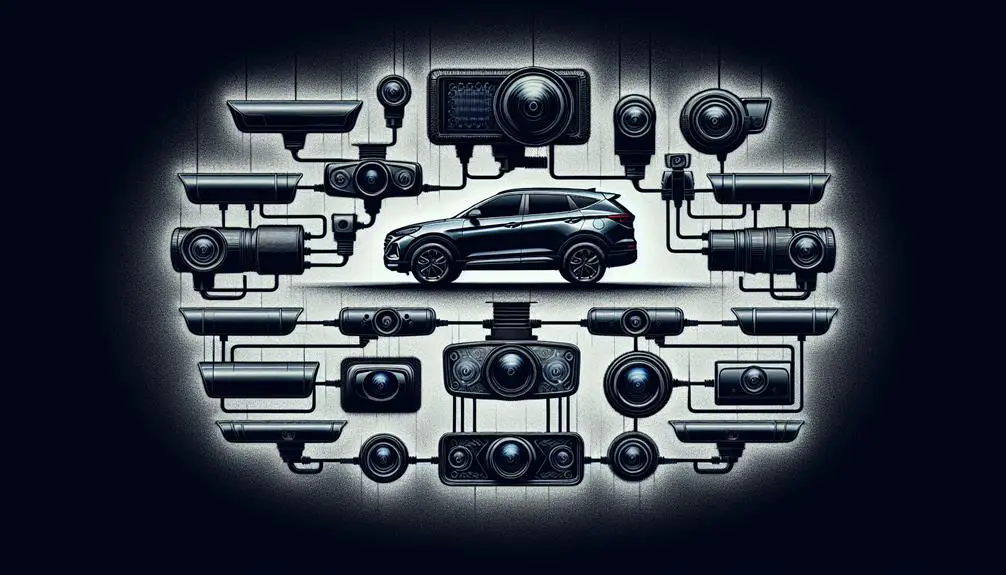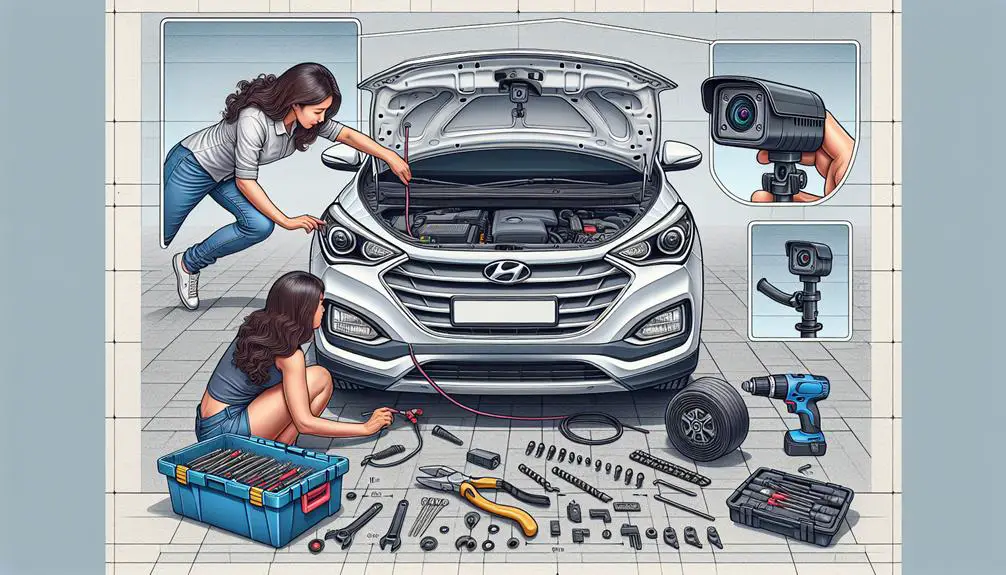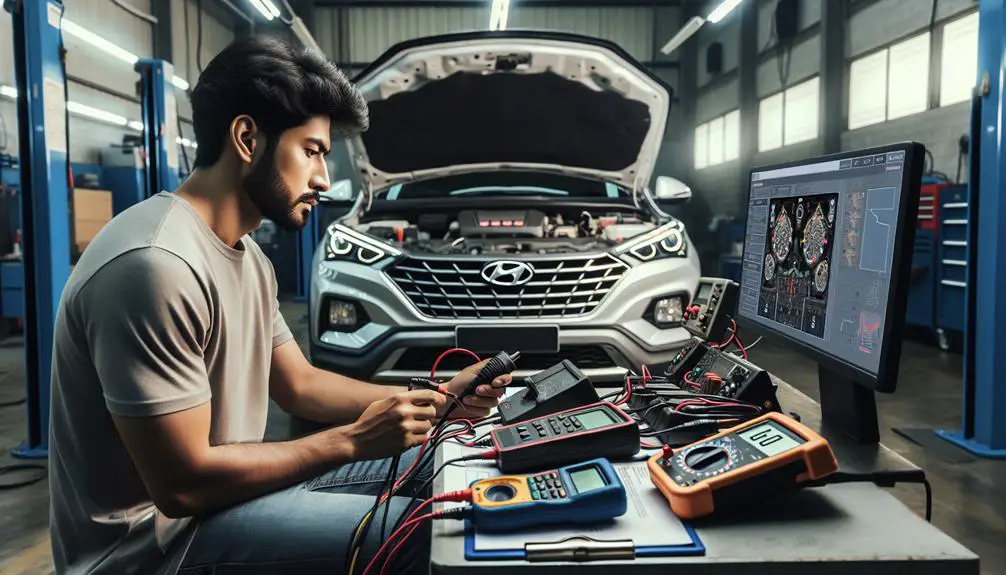Installing a backup camera typically involves mounting the camera on the rear of the vehicle, connecting it to the power source and the display unit inside the car, and routing the necessary wires.
It is essential to follow the instructions provided with the camera kit and ensure that the connections are secure to avoid any issues with the camera's functionality.
If you are comfortable with basic tools and have some experience with car electronics, you should be able to complete the installation process successfully.
However, if you are unsure about any step or encounter difficulties during the installation, it is advisable to seek professional help to ensure the camera is installed correctly and functions properly.
Choosing the Right Camera

Selecting the right backup camera for your Hyundai Santa Fe is the initial crucial step in enhancing your vehicle's safety and convenience. It's not just about picking any camera off the shelf; it's about finding the one that fits your needs and integrates seamlessly with your vehicle. You've got to think about several factors to make sure you're making the best choice.
First and foremost, compatibility is key. You need to make sure the camera you're eyeing is compatible with your Santa Fe's model year. There's no use in getting a high-tech camera if it can't communicate with your car's existing systems. Check the manufacturer's specifications or consult with a professional to avoid any costly mistakes.
Next, think about the camera's resolution and viewing angle. You want a camera that provides a clear, wide view of what's behind you. Higher resolution cameras offer better image quality, especially in low-light conditions. A wide viewing angle, around 170 degrees, is ideal for covering blind spots.
Moreover, consider the camera's durability and weather resistance. Since it'll be exposed to different elements, you need a camera that's built to last. Look for waterproof and dustproof ratings to make sure your camera can withstand harsh weather conditions.
To end, don't overlook ease of installation. While you're not diving into the specifics of the installation process right now, choosing a camera that's known for straightforward installation can save you time and potential headaches later on.
Gathering Necessary Tools
Before you start on installing a backup camera in your Hyundai Santa Fe, it's important to gather all the necessary tools for a smooth and efficient process.
Initially, you'll need a screwdriver set. This isn't just any screwdriver set, though. Make sure you've got a variety of sizes and types, including Phillips and flat-head, to accommodate the different screws you might encounter.
Next, grab a panel removal tool. This will be your best friend when it comes to safely removing and reattaching the interior panels without causing any damage.
Don't forget a drill with a range of drill bits. You'll need this for creating any necessary holes for the camera or wiring. It's better to have a range of sizes to ensure you can adjust based on the specific requirements of your backup camera kit.
A wire stripper and crimping tool are also important. You'll be dealing with some wiring work, and these tools will help you make clean, safe connections. Make sure you're familiar with how to use them properly to avoid any mishaps.
Lastly, have some electrical tape and cable ties on hand. These will help you tidy up any loose wires, ensuring your installation looks professional and reduces the risk of any wires getting caught or damaged.
Gathering these tools before you start will save you time and frustration. You'll be prepared for each step of the installation, making the process smoother and more enjoyable.
Camera Installation Process

Now that you've gathered all the necessary tools, let's start installing the backup camera on your Hyundai Santa Fe.
Initially, you'll need to decide the exact spot where you want to mount the camera. Typically, the best place is just above the rear license plate as it offers a clear view of what's behind you. Make sure the area is clean and dry before you proceed.
Next, you're going to attach the camera mounting bracket. If your model requires drilling holes, carefully mark the spots with a pencil. Double-check the alignment to make sure your camera will have an unobstructed view. Then, using a drill, create the necessary holes. If your camera uses an adhesive mount, simply peel off the backing and press it firmly into place, following the manufacturer's instructions for the best hold.
Once the bracket is secure, it's time to mount the camera. This part should be straightforward: align the camera with the bracket and secure it according to the manufacturer's instructions. This usually involves tightening a few screws to make sure the camera won't move or vibrate while you're driving.
Wiring and Connectivity
With the camera securely mounted, it's time to tackle the wiring and make sure your backup camera is properly connected to your Hyundai Santa Fe's electrical system. Proper wiring is vital for the functionality and reliability of your backup camera. Let's walk through the key steps to make a smooth connection process.
- Identify the Power Source: Your backup camera needs power to operate. You'll usually connect it to the reverse light power wire in your Hyundai Santa Fe. This guarantees the camera turns on when you shift into reverse. Locate the reverse light wire in the tail light assembly and use a test light or multimeter to confirm you've got the right one.
- Make the Power Connection: After identifying the reverse light power wire, carefully splice the camera's power cable into it. It's essential to use a proper wire connector and make a secure connection to avoid any loose wires or electrical shorts.
- Route the Video Cable: The next step is to route the video cable from the camera to the display monitor in the cabin. Plan the route to avoid any moving parts or heat sources that could damage the cable. Use cable ties to secure the cable along the way.
- Connect to the Display Monitor: Lastly, connect the video cable to your display monitor. Depending on your setup, this might be an aftermarket monitor or your vehicle's existing infotainment system. Make sure the connection is tight and secure.
Testing and Troubleshooting

After you've connected the backup camera and monitor in your Hyundai Santa Fe, it's time to test the system to make sure everything operates smoothly. Turn on your vehicle's ignition and shift into reverse. You should see the camera's view on your monitor immediately. If it doesn't display, don't panic. There are a few steps you can take to troubleshoot the issue.
Initially, check all connections to make sure they're secure and correctly plugged in. A loose connection is often the culprit behind a non-functioning backup camera. If everything seems tight, the next step is to inspect the power source. Make sure the camera and monitor are receiving power. This can be confirmed with a multimeter at the wiring connections.
If power isn't the issue, then it could be a compatibility problem between your camera and the monitor. Double-check that all components are compatible with each other and your Hyundai Santa Fe. Sometimes, firmware updates for the monitor or camera can resolve these compatibility issues.
Should the system still fail to work, review the installation instructions to make sure no steps were missed. It's easy to overlook a small but important detail in the installation process. If you've gone through all these steps and the camera still isn't working, it might be time to consult with a professional. There could be a deeper electrical issue at play that requires expert attention.
Conclusion
Congratulations! You've now successfully installed a backup camera on your Hyundai Santa Fe. By carefully choosing the right camera, gathering the necessary tools, and meticulously following the installation and wiring process, you've enriched your vehicle's safety features.
Don't forget to test the system thoroughly and troubleshoot any issues that might arise. Enjoy the added convenience and safety of your new backup camera every time you reverse. Safe driving!